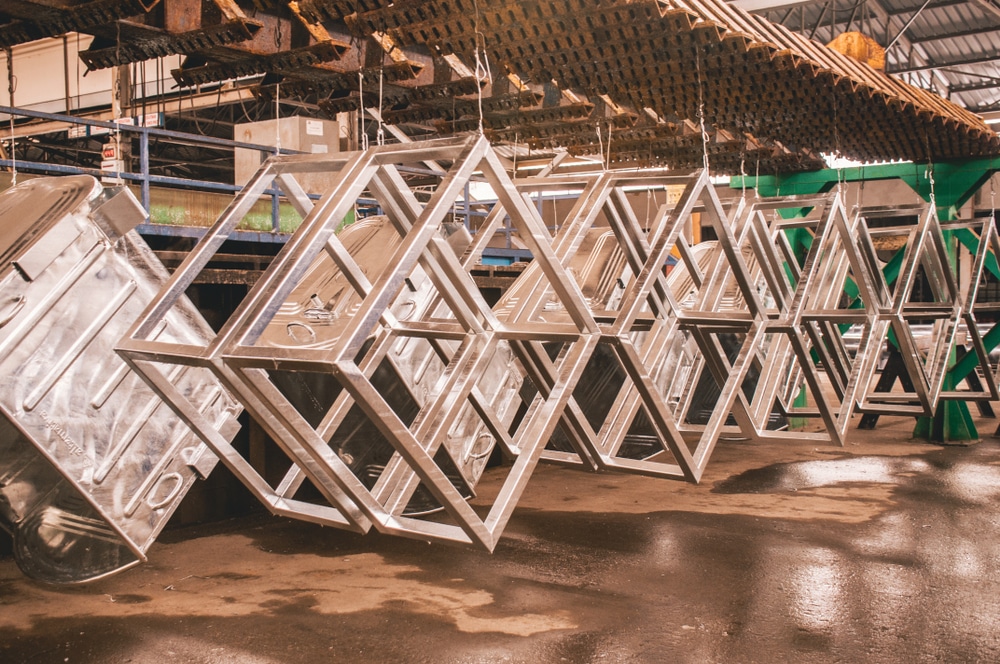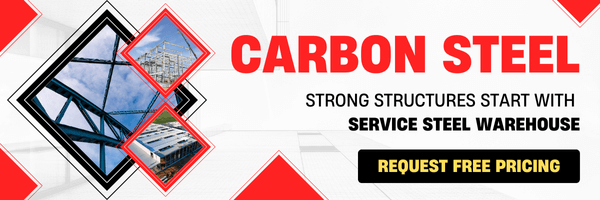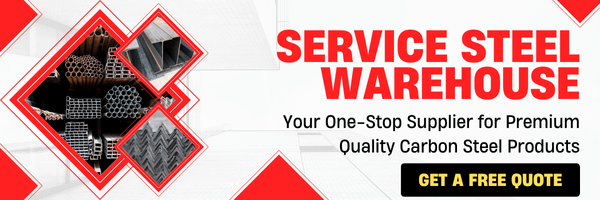Types of Steel Coatings and Metal Finishes
June 11, 2025 | Categorized in: Applications

Metals have been harnessed for their strength, durability, and aesthetic appeal for centuries, but it’s the application of coatings and finishes that truly brings out their full potential. These techniques enhance the appearance and durability of metal objects and protect them from corrosion and rust.
In this blog post, we’ll explain the intricate universe of metal coatings, highlighting the various types, methods, finishes, and applications that enable us to mold metal into something truly extraordinary. From the towering steel skyscrapers that define our cities to the subtle, refined accents in our everyday lives, the choices in metal coatings and finishes are as diverse as they are essential.
Find the information you need:
- What are metal coatings?
- Advantages of metal coatings and finishes
- Common types of metal coatings and finishes
What are metal coatings?
Metal coatings are thin layers of material applied to the surface of metal, typically referred to as the substrate. These coatings serve various purposes, including protection, enhancement, and functionality. This protection is essential in extending the lifespan of metal products, especially those exposed to harsh conditions. In various applications and industries, metal coatings also function as torque agents or lubricants, protecting components like fasteners, screws, and bolts from damage over time.
One of the most widely used examples of metal coating is galvanized steel. By immersing steel in a bath of molten zinc, it forms a protective barrier that protects the underlying steel from rusting. This zinc “coat” provides excellent corrosion protection, making it widely used in applications where metal is exposed to harsh environments.
Coating vs. finishes: What’s the difference?
Metal coatings and finishes are both surface treatments applied to metal materials to enhance their appearance, improve durability, and/or provide specific functional properties. Metal coatings typically involve the application of a thin layer of a different metal or alloy onto the surface of a substrate to increase durability or prevent corrosion. Metal finishes, on the other hand, focus on enhancing the appearance of the metal surface without necessarily adding a protective layer.
Advantages of metal coatings and finishes
Metal coatings and finishes both offer a diverse set of advantages, ranging from protection against corrosion and wear, to aesthetics and functionality improvements. These benefits make them essential in a wide range of industries, including manufacturing, construction, electronics, and design. Some of their key advantages include:
Prevents corrosion
Many metal coatings, such as galvanization and various types of steel plating, can act as a protective barrier, preventing the underlying metal from rusting when exposed to moisture, chemicals, or environmental factors. This is particularly important for outdoor and marine applications, as well as parts exposed to harsh chemicals or environments.
Improves durability
Metal coatings can significantly increase the lifespan and durability of components by making them stronger and more resistant to intense wear, as well as repeated abrasions. This is particularly useful in industries like automotive manufacturing, where parts are subject to constant stress.
Enhances aesthetics
Metal finishes allow for the customization of the appearance and texture of metal surfaces, enabling designers and architects to achieve unique visual effects and meet specific design requirements.
Improves electrical performances
Some metal coatings are used to enhance electrical conductivity, making them valuable in the electronics industry for components like connectors and conductive traces.
Provides surface protection
Some metal finishes, like anodizing, provide a protective layer on the surface that helps to guard against light scratches and abrasions. This is valuable for components exposed to harsh environmental conditions.
Common types of metal coatings and finishes
There are numerous types of metal finishes and coating, each designed to serve specific purposes and achieve particular outcomes. Below are some of the most common types with more information about how they’re made, what purpose they serve, and what makes them unique.
Paint coating
Paint coatings for steel metal serve a dual purpose of protection and aesthetics. They create a protective barrier between the steel surface and the surrounding environment, guarding against corrosion. Simultaneously, paint coatings enhance the visual appeal of steel, allowing for customization through a wide range of colors, textures, and finishes. The four most common types of paint for coated steel include:
- Epoxy
- Polyurethane
- Acrylic
- Alkyd
Galvanization coatings
Galvanizing steel is one of the oldest metal coating processes known, dating back to the 18th century. Today, galvanization can be done in two different ways:
- Hot-dip galvanization is a process in which the metal, typically steel, is immersed in a bath of molten zinc or using a galvanic coating method.
- Electrogalvanization (a.k.a zinc plating) is a method that uses an electric current to deposit a thin and uniform zinc layer onto the metal.
In both, the zinc layer acts as a sacrificial anode, breaking down in place of the underlying steel when exposed to corrosive elements. This makes galvanized steel coatings an ideal choice for applications when the metal is constantly subjected to moisture and harsh weather conditions, such as fencing, roofing, and electrical conduits.
Sherardizing steel
Sherardizing is a hot-dip galvanizing process, but it differs from traditional galvanizing in a few key ways. Mainly, this process produces a zinc-iron alloy coating that produces a uniform and protective layer, even on complex shapes. While hot-dip galvanization is commonly used for larger structural components like beams and pipes, this coating is most often used on small, intricate, or threaded objects.
Powder coating
Powder coating is a method of applying a protective and decorative finish to metal surfaces. It involves spraying a fine powder of thermosetting resins and pigments onto the metal object. The powder particles are then electrostatically charged, causing them to adhere to the metal’s surface. The coated item is then heated in an oven, allowing the powder to melt and create a smooth, even, and durable finish as it cools and solidifies.
This process has a few unique advantages that make it a popular choice for numerous applications:
- Powder coatings are also environmentally friendly as they produce minimal volatile organic compounds (VOCs) and waste.
- They come in a wide array of color and finish options, allowing for creative and customized designs.
- Powder coating finishes are cost-effective in the long term as it reduces the need for frequent maintenance and recoating.
Anodizing
Anodizing is a specialized coating method primarily applied to aluminum surfaces. By immersing the aluminum in an electrolyte solution and applying an electric current, a controlled oxide layer forms on the metal’s surface. Anodized coatings are commonly used in industries such as aerospace, automotive, construction, and consumer electronics, where both protection and aesthetics are critical considerations.
Bead blasting
Bead blasting, also known as abrasive blasting, is a surface preparation process used in metal finishing. It involves propelling small, coarse beads or particles at high velocity onto the surface of a metal component. The abrasive beads are most commonly in the form of:
- Glass beads
- Ceramic beads
- Steel shot
The impact of these beads against the metal surface removes impurities, scale, rust, old coatings, and other contaminants, leaving a clean and textured finish.
Electroplating
Electroplating is a versatile method used to enhance the appearance and properties of metal. It involves immersing a metal workpiece in an electrolyte bath and passing an electric current through it, causing a thin layer of a different metal to be deposited onto its surface. Nickel, chromium, and gold are frequently used for electroplating. This process offers a wide range of benefits, such as:
- Improved corrosion resistance
- Enhanced wear resistance
- Thin enough for decorative finishes
1. Electroless plating
With similar utility as electroplating, electroless plating is a metal coating method that doesn’t use an external electrical current. Unlike electroplating, which relies on an external power source to drive the deposition of metal ions onto a substrate, electroless plating relies on chemical reactions to achieve the same result.
This method has its unique advantages, including the ability to coat complex or irregularly shaped objects uniformly and to achieve a precise thickness of the coating. However, it requires careful control of chemical parameters and can be more expensive than electroplating for some applications.
2. Electropolishing
Similar to the method of electroplating, electropolishing is a finishing process used to remove a controlled amount of material from the surface of a metal object. The electropolishing process involves immersing the metal object to be treated in an electrolyte bath and applying an electrical current.
This method is used to improve the surface finish, enhance the appearance, and, in many cases, improve the corrosion resistance of the treated metal. It’s typically used on stainless steel, but it can also be used on other metals such as carbon steel, copper, and titanium.
Thermal spray coating
Thermal spraying is a metal coating process that involves melting or partially melting a metallic material and then spraying it onto a substrate (usually metal, but sometimes plastic) to create a protective, decorative, or functional coating. When it comes to generating the high temperatures required for thermal spray coating, there are a few different methods:
- Combustion spraying uses a combustion flame to melt the coating material, which is then sprayed onto the metal surface.
- Plasma spraying uses a high-temperature plasma arc to melt the coating material.
- High-velocity oxy-fuel (HVOF) spraying utilizes a high-velocity oxygen-fuel gas mixture to generate a supersonic flame.
- Electric arc spraying is used to melt the coating material, and the molten droplets are sprayed onto the substrate using a gas stream.
- Detonation gun (d-gun) spraying is a specialized method that uses a controlled detonation to create a high-velocity gas jet.
Enhance and Protect Your Metal Projects with Service Steel
The world of metal coatings and finishes offers a wide array of options to enhance the durability, aesthetics, and performance of your metal projects. Whether you’re looking for the corrosion resistance of galvanizing, the sleek appearance of powder coating, or the versatility of galvanization, there’s a solution to meet your specific needs.
If you’re considering a metal coating or finish for your next project, don’t hesitate to explore Service Steel’s comprehensive galvanizing options. Our team of experts is ready to assist you in finding the perfect solution to protect and enhance your steel assets. Your success begins with the right metal coating – choose Service Steel for unparalleled quality and service!
Contact us today to request a quote (or give us a call) and take the first step toward ensuring your project stands the test of time.

